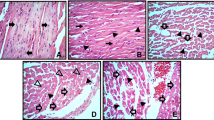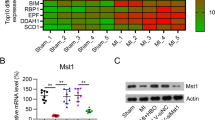Abstract
Although numerous advancements made in the field of human health have resulted in reduced deaths due to cardiovascular diseases (CVD), many patients with cardiac disease show no established risk. Therefore, other unknown factors may be responsible for the pathophysiology of CVD. Out of 350,000 sudden cardiac deaths each year in the United States, 60,000 deaths have been related to air pollution, suggesting a detrimental role of environmental pollutants in the development of CVD. The present study tested our hypothesis that chronic ozone exposure enhances the sensitivity to ischemia–reperfusion (I/R) injury in isolated perfused hearts. Sprague-Dawley rats were continuously exposed for 8 h/day for 28 and 56 days to filtered air or 0.8 ppm ozone. Isolated hearts were subjected to 30 min of global ischemia followed by 60 min of reperfusion. Cardiac function after I/R measured as left ventricular developed pressure (LVDP), +dP/dt, –dP/dt, and left ventricular end diastolic pressure (LVEDP) was significantly decreased and increased respectively in ozone-exposed I/R hearts compared to I/R hearts exposed to filtered air. The enhanced sensitivity to I/R injury upon ozone exposure was associated with increased myocardial TNF-α levels and lipid peroxidation and decreased myocardial activities of superoxidase dismutase (SOD) and IL-10. These data suggest that ozone-induced sensitivity to myocardial I/R injury may be due to promoting levels of oxidative stress as well as inflammatory mediators.







Similar content being viewed by others
References
Levy D, Wilson P (1998) Atherosclerotic cardiovascular disease: an epidemiological perspective. In: Topol E (ed) Comprehensive cardiovascular medicine. Lippincott-Raven, Philadelphia, PA, pp 27–43
Hennekens C (1998) Increasing burden of cardiovascular disease: current knowledge and future directions for research on risk factors. Circulation 97:1095–1102
Heller RF, Chinn S, Tunstall Pedoe HD, Rose G (1984) How can we predict coronary heart disease? Findings in the United Kingdom Heart Disease Prevention Project. BMJ 288:1409–1411
Mastin JP (2005) Environmental cardiovascular disease. Cardiovasc Toxicol 5:91–94
Gong H Jr, Wong R, Sarma RJ, Linn WS, Sullivan ED, Shamoo DA, Anderson KR, Prasad SB (1998) Cardiovascular effects of ozone exposure in human volunteers. Am J Respir Crit Care Med 158:538–546
Sathish Kumar K, Haque M, Perumal TE, Francis J, Uppu RM (2005) A major ozonation product of cholesterol, 3beta-hydroxy-5-oxo-5,6-secocholestan-6-al, induces apoptosis in H9c2 cardiomyoblasts. FEBS Lett 579(28):6444–6450
Gold DR, Litonjua A, Schwartz J, Lovett E, Larson A, Nearing B, Allen G, Verrier M, Cherry R, Verrier R (2000) Ambient pollution and heart rate variability. Circulation 101(11):1267–1273
Arito H, Uchiyama I, Arakawa H, Yokoyama E (1990) Ozone induced bradycardia and arrhythmia and their relation to sleep-wakefulness in rats. Toxicol Lett 52:169–178
Ruidavets JB, Cournot M, Cassadou S, Giroux M, Meybeck M, Ferrieres J (2005) Ozone air pollution is associated with acute myocardial infarction. Circulation 111:563–569
Di Filippo C, Marfella R, Capodanno P, Ferraraccio F, Coppola L, Luongo M, Mascolo L, Luongo C, Capuano A, Rossi F, D’Amico M (2008) Acute oxygen-ozone administration to rats protects the heart from ischemia reperfusion infarct. Inflamm Res 57:445–449
Merin O, Attias E, Elstein D, Schwalb H, Bitran D, Zimran A, Silberman S (2007) Ozone administration reduces reperfusion injury in an isolated rat heart model. J Card Surg 22:339–342
Yang W, Omaya ST (2008) Air pollutants, oxidative stress and human health. Mutat Res, Nov [Epub ahead of print]
Berglind N, Bellander T, Forastiere F, von Klot S, Aalto P, Elosua R, Kulmala M, Lanki T, Löwel H, Peters A, Picciotto S, Salomaa V, Stafoggia M, Sunyer J, Nyberg F, HEAPSS Study Group (2008) Ambient air pollution and daily mortality among survivors of myocardial infarction. Epidemiology 20(1):110–118
Wong CM, Vichit-Vadakan N, Kan H, Qian Z, Ostro B, The PAPA Project Teams (2008) Public health and air pollution in ASIA. Environ Health Perspect 116:1195–1202
Middleton N (2008) A 10 year time-series analysis and cardiovascular mortality in Cyprus. Environ Health 22:39–45
Medina RM, Schwartz J (2008) Who is more vulnerable to die from ozone air pollution? Epidemiology 19:672–679
Mitis F, Iavarone I, Martuzzi M (2007) Health impact of ozone in 13 Italian cities. Epidemiol Prev 31:323–332
Bocci V (2006) Is it true that ozone is always toxic? The end of a dogma. Toxicol Appl Pharmacol 216:493–504
Brooke RD (2008) Cardiovascular effects of air pollution. Clin Sci 115:175–187
Wiester MJ, Tepper JS, King ME, Menache MG, Costa DL (1998) Comparative study of ozone (O3) uptake in three strains of rats and in the guinea pig. Toxicol Appl Pharmacol 96:140–146
Sethi R, Dhalla NS (1995) Inotropic responses to isoproterenol in congestive heart failure subsequent to myocardial infarction in rats. J Card Fail 1(5):391–399
Singla DK, Kaur K, Sharma AK, Dhingra S, Singal PK (2007) Probucol promotes endogenous antioxidant reserve and confers protection against reperfusion injury. Can J Physiol Pharmacol 85:439–443
Buege JA, Aust SD (1978) Microsomal lipid peroxidation. Methods Enzymol 52:302–310
Urich D, Soberanes S, Burgess Z, Chiarella SE, Ghio AJ, Ridge KM, Kamp DW, Chandel NS, Mutlu GM, Budinger GR (2009) Proapoptotic noxa is required for particulate matter-induced cell death and lung inflammation. Faseb J [Epub ahead of print]
Bagate K, Meiring JJ, Gerlofs-Nijland ME, Cassee FR, Wiegand H, Osornio-Vargas A, Borm PJ (2006) Ambient particulate matter affects cardiac recovery in a Langendorff ischemia model. Inhal Toxicol 18:633–643
Cozzi E, Hazarika S, Stallings HW 3rd, Cascio WE, Devlin RB, Lust RM, Wingard CJ, Van Scott MR (2006) Ultrafine particulate matter exposure augments ischemia–reperfusion injury in mice. Am J Physiol 291:H894–H903
Vancza EM, Galdanes K, Gunnison A, Hatch G, Gordon T (2009) Age, strain, and gender as factors for increased sensitivity of the mouse lung to inhaled ozone. Toxicol Sci 107(2):535–543
Watkinson WP, Campen MJ, Nolan JP, Costa DL (2001) Cardiovascular and systemic responses to inhaled pollutants in rodents: effects of ozone and particulate matter. Environ Health Perspect 109:539–546
Fakhrzadeh L, Laskin JD, Gardner CR, Laskin DL (2003) SOD overexpressing mice are resistant to ozone induced tissue injury and increases in NO and TNF alpha. Am J Respir Cell Mol Biol 30(3):280–287
Chuang KJ, Chan CC, Su TC, Lee CT, Tang CS (2007) The effect of urban air pollution on inflammation, oxidative stress, coagulation, and autonomic dysfunction in young adults. Am J Respir Crit Care Med 176:370–376
Muzykantov VR (2001) Delivery of antioxidant enzyme proteins to the lung. Antioxid Redox Signal 3:39–62
Comhair SA, Erzurum SC (2002) Antioxidant responses to oxidant mediated lung diseases. Am J Physiol lung 283:246–255
Noor R, Mittal S, Iqbal J (2002) Superoxidase dismutase applications and relevance to human disease. Med Sci Monit 8:210–215
Jonsson LM, Edlund T, Marklund SL, Sandström T (2002) Increased ozone-induced airway neutrophilic inflammation in extracellular-superoxide dismutase null mice. Respir Med 96:209–214
Bhalla DK, Reinhart PG, Bai C, Gupta SK (2002) Amelioration of ozone induced lung injury by anti-tumor necrosis factor-alpha. Toxiol Sci 69(2):400–408
Kapadia SR, Oral H, Lee J, Nakano M, Taffet GE, Mann DL (1997) Hemo-dynamic regulation of tumor necrosis factor-α and protein expression in adult feline myocardium. Circ Res 81:187–195
Meldrum DR, Cleveland JC, Caun BS, Meng X, Harken AH (1998) Increased myocardial TNF-α in a crystalloid perfused model of cardiac ischemic-reperfusion injury. Ann Thorac Surg 65:439–443
Kubota T, McTiernan CF, Frye CS, Slawson SE, Lemster BH, Koretsky AP, Demetris AJ, Feldman A (1997) Dilated cardiomyopathy in transgenic mice with cardiac specific overexpression of TNF-α. Circ Res 81:627–638
Dhingra S, Sharma AK, Arora RC, Slezak J, Singal PK (2009) IL-10 attenuates TNF-{alpha}-induced NF{kappa}B pathway activation and cardiomyocyte apoptosis. Cardiovasc Res, Feb 18 [Epub ahead of print]
Köken T, Serteser M, Kahraman A, Akbulut G, Dilek ON (2004) Which is more effective in the prevention of renal ischemia-reprofusion-induced oxidative injury in the early period in mice: interleukin (IL)-10 or anti-IL-12? Clin Biochem 37:50–55
Das M, Cui J, Das DK (2006) Generation of survival signal by different interaction of p38MAPKalpha and p38MAPKbeta with caveolin-1 and caveolin-3 in the adapted heart. J Mol Cell Cardiol 42(1):206–213
Ballard-Croft C, Locklar AC, Kristo G, Lasley RD (2006) Regional myocardial ischemia-induced activation of MAPKs is associated with subcellular redistribution of caveolin and cholesterol. Am J Physiol 291:H658–H667
Fakhrzadeh L, Laskin JD, Laskin DL (2007) Regulation of caveolin-1 expression, nitric oxide production and tissue injury by tumour necrosis factor-alpha following ozone inhalation. Toxicol Appl Pharmacol 227:380–389
Murata T, Lin MI, Huang Y, Yu J, Bauer PM, Giordano FJ, Sessa WC (2007) Re-expression of caveolin-1 in endothelium rescues the vascular, cardiac, and pulmonary defects in global caveolin-1 knockout mice. J Exp Med 204(10):2373–2382
Williams AS, Issa R, Durham A, Leung SY, Kapoun A, Medicherla S, Higgins LS, Adcock IM, Chung KF (2008) Role of p38MAPK in ozone-induced airway hyper-responsiveness and inflammation. Eur J Pharmacol 600:117–122
Bhalla DK, Gupta SK, Reinhart PG (1999) Alteration of epithelial integrity, alkaline phosphatase activity and fibronectin expression in lungs of rats exposed to ozone. J Toxicol Environ Health A57:329–343
Dhalla NS, Sethi R, Dakshinamurthi K (2000) Treatment of cardiovascular and related pathologies, United States Patent 6043259
Hatch GE, Slade R, Harris LP, McDonnell WF, Devlin RB, Koren HS, Costa DL, McKee J (1994) Ozone dose and effect in humans and rats: a comparison using oxygen-18 labeling and bronchoalveolar lavage. Am J Respir Crit Care Med 150:676–683
Miller FJ (1995) Uptake and fate of ozone in the respiratory tract. Toxicol Lett 82–83:277–285
Rouslin W, Broge CW, Guerrieri F, Capozza G (1995) ATPase activity, IF1 content, and proton conductivity of ESMP from control and ischemic slow and fast heart-rate hearts. J Bioenerg Biomembr 27(4):459–466
Tardif JC, Carrier M, Kandzari DE et al (2007) Effects of pyridoxal-5-phosphate in patients undergoing high risk coronary artery bypass surgery: results of MED-CABG randomized trial. J Thorac Cardovasc Surg 133(6):1604–1611
Miller JF, Menzel DB, Coffin DL (1978) Similarity between man and laboratory animals in regional pulmonary deposition of ozone. Environ Res 17:84–101
Wiester MJ, Stevens MA, Menache MG, McKee JL Jr, Gerrity TR (1996) Ozone uptake in healthy adult males during quiet breathing. Fundam Appl Toxicol 29:102–109
Acknowledgments
This work was supported by grants from Texas A&M Health Science Center (TAMHSC), Texas A&M University Kingsville (TAMUK) and US Environmental Protection Agency. We thank Dr. Kuruvilla John and Mr. Don Marek from the Department of Environmental Engineering at TAMUK for their technical support and advice. We are also grateful to TAMUK-Ronald McNair Scholars—Miss Patricia Hinojosa and Mr. Daniel Diaz, TAMHSC-Pharm D student—Ms. BaAimee Nguyen and the King High School-AP Biology Student—Mr. Vishal Sethi for laboratory assistance.
Author information
Authors and Affiliations
Corresponding author
Rights and permissions
About this article
Cite this article
Perepu, R.S.P., Garcia, C., Dostal, D. et al. Enhanced death signaling in ozone-exposed ischemic-reperfused hearts. Mol Cell Biochem 336, 55–64 (2010). https://doi.org/10.1007/s11010-009-0265-4
Received:
Accepted:
Published:
Issue Date:
DOI: https://doi.org/10.1007/s11010-009-0265-4




